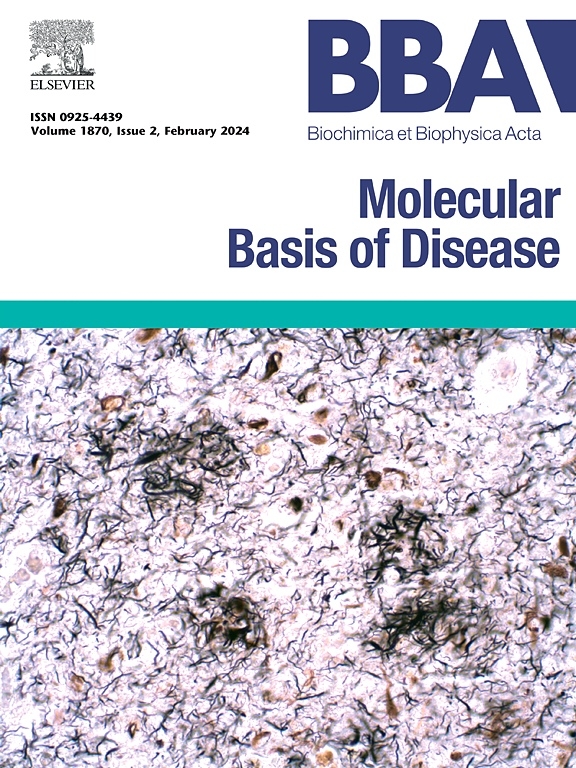SIRT5介导的sucl2琥珀酰化调节急性胰腺炎胰腺腺泡细胞的TCA循环功能障碍和线粒体损伤。
IF 4.2
2区 生物学
Q2 BIOCHEMISTRY & MOLECULAR BIOLOGY
Biochimica et biophysica acta. Molecular basis of disease
Pub Date : 2024-12-04
DOI:10.1016/j.bbadis.2024.167613
引用次数: 0
摘要
急性胰腺炎(AP)是一种与代谢重编程和线粒体功能障碍相关的严重炎症性疾病。本研究通过对AP发生过程中胰腺腺泡细胞中心碳代谢变化的研究,阐明了三羧酸(TCA)循环紊乱的分子机制,并探讨了蛋白高琥珀酰化在AP发病中的作用。通过体外和体内AP模型,靶向代谢组学和生物信息学分析显示,TCA循环失调的特征是琥珀酰辅酶a升高和琥珀酸盐水平降低。比色分析、质谱分析和定点诱变表明,SIRT5下调导致sucl2在K118位点高琥珀酰化,抑制琥珀酰辅酶a合成酶活性,引发琥珀酰辅酶a积累和sucl2琥珀酰化的恶性循环。腺病毒介导的SIRT5过表达和sucl2敲低阐明了SIRT5- sucl2通路在调节TCA循环紊乱中的作用。蛋白琥珀酰化水平与胰腺组织损伤和线粒体损伤严重程度呈正相关。琥珀酰化分析发现细胞色素c1 (CYC1)是一个关键的高琥珀酰化蛋白,sirt5 - sucl2通路调节其琥珀酰化水平和电子传递链复合物III的活性。高琥珀酰化诱导线粒体DNA释放,激活cGAS-STING通路,导致多器官功能障碍综合征。调节sirt5 - sucl2轴可减轻AP中TCA循环失调、蛋白高琥珀酰化、线粒体损伤和炎症反应。这些发现揭示了连接sirt5 - sucl2轴、TCA循环功能障碍和蛋白高琥珀酰化在AP发病机制中的新机制,为AP治疗提供了潜在的治疗靶点。本文章由计算机程序翻译,如有差异,请以英文原文为准。

SIRT5 mediated succinylation of SUCLA2 regulates TCA cycle dysfunction and mitochondrial damage in pancreatic acinar cells in acute pancreatitis
Acute pancreatitis (AP) is a severe inflammatory disorder associated with metabolic reprogramming and mitochondrial dysfunction. This study investigated central carbon metabolism alterations in pancreatic acinar cells during AP, elucidated the molecular mechanisms of tricarboxylic acid (TCA) cycle disorders, and explored the role of protein hypersuccinylation in AP pathogenesis. Using in vitro and in vivo AP models, targeted metabolomics and bioinformatics analyses revealed TCA cycle dysregulation characterized by elevated succinyl-CoA and decreased succinate levels. Colorimetric assays, mass spectrometry, and site-directed mutagenesis demonstrated that SIRT5 downregulation led to SUCLA2 hypersuccinylation at K118, inhibiting succinyl-CoA synthetase activity and triggering a vicious cycle of succinyl-CoA accumulation and SUCLA2 succinylation. Adenovirus-mediated SIRT5 overexpression and SUCLA2 knockdown clarified the SIRT5-SUCLA2 pathway's role in regulating TCA cycle disorders. Protein succinylation levels positively correlated with pancreatic tissue damage and mitochondrial injury severity. Succinylome analysis identified cytochrome c1 (CYC1) as a key hypersuccinylated protein, and the SIRT5-SUCLA2 pathway regulated its succinylation level and electron transport chain complex III activity. Hypersuccinylation induced mitochondrial DNA release, activating the cGAS-STING pathway, contributing to multiple organ dysfunction syndrome. Modulating the SIRT5-SUCLA2 axis attenuated TCA cycle dysregulation, protein hypersuccinylation, mitochondrial damage, and inflammatory responses in AP. These findings reveal novel mechanisms linking the SIRT5-SUCLA2 axis, TCA cycle dysfunction, and protein hypersuccinylation in AP pathogenesis, providing potential therapeutic targets for AP treatment.
求助全文
通过发布文献求助,成功后即可免费获取论文全文。
去求助
来源期刊
CiteScore
12.30
自引率
0.00%
发文量
218
审稿时长
32 days
期刊介绍:
BBA Molecular Basis of Disease addresses the biochemistry and molecular genetics of disease processes and models of human disease. This journal covers aspects of aging, cancer, metabolic-, neurological-, and immunological-based disease. Manuscripts focused on using animal models to elucidate biochemical and mechanistic insight in each of these conditions, are particularly encouraged. Manuscripts should emphasize the underlying mechanisms of disease pathways and provide novel contributions to the understanding and/or treatment of these disorders. Highly descriptive and method development submissions may be declined without full review. The submission of uninvited reviews to BBA - Molecular Basis of Disease is strongly discouraged, and any such uninvited review should be accompanied by a coverletter outlining the compelling reasons why the review should be considered.

 求助内容:
求助内容: 应助结果提醒方式:
应助结果提醒方式:


